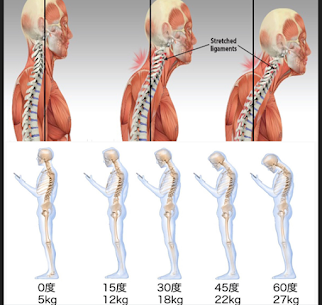
In this article, I would like to talk about military neck, or cervical kyphosis, which has been in the spotlight for quite some time now.
Military neck is not the official name of the disease, but rather a medical term for a condition in which the cervical spine deviates from its ideal forward curvature, meaning that the original kyphosis is reduced or eliminated. In other words, it is a condition in which the cervical vertebrae become straight.
When the neck moves forward, the shoulders naturally get rounded, and the shoulder blades tend to expand outward.
When the angle of alignment between the shoulders and the front of the ears is at 0 degrees, the whole weight of the head, or about 5 kg, is placed on the neck.
As the angle at which the head is tilted forward increases, the load becomes stronger: 12 kg at 15 degrees, 18 kg at 30 degrees, 22 kg at 45 degrees, 27 kg at 60 degrees, etc. Because the neck must continuously uphold this weight, the neck and shoulders can become very stiff.
Since it is difficult for the neck to bear this weight alone, the back and lumbar area must in turn support it in various places.
Some back muscles are attached from the pelvis to the neck and shoulders, so when the neck and shoulders move forward, the muscles in the back get stretched.
Muscles can be used in a contracted or stretched position, and when muscles are used in the stretched position, quite a lot of strain is placed on the body.
As a result, when the neck is extended forward beyond its usual position, it places a greater strain on the lumbar region, back muscles, and ligaments.
At the same time, the pelvis is often tilted backward, inducing a hunched posture, and increasing the strain on the intervertebral discs.
The cause of is not limited to the lumbar area but can be caused by various parts of the body, including the upper and lower body.
The persons who work with their hands in front of them, such as computer users, office workers, and drivers, should take extra precautions.
Daily preventive measures are essential to protect your body.
Our clinic is made up of a team of specialists in back pain, so if you are suffering from back pain, feel free to call us.
* The criterion for a straight neck is a standard angle of 30°to 40°between the top bone and the bottom bone as observed on an X-ray.
When the angulation is off, the patient develops a straight neck.
* There can be some errors in diagnostic criteria depending on the reference source.
International Lumbago Clinic Tokyo



